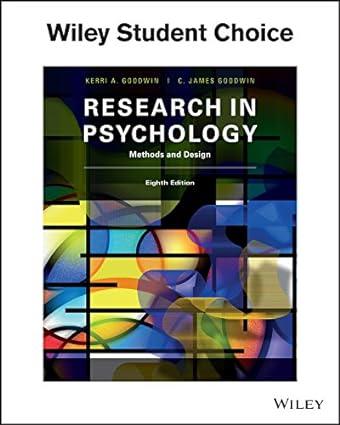For each of the following studies, decide whether to illustrate the described outcomes with a line graph
Question:
For each of the following studies, decide whether to illustrate the described outcomes with a line graph or a bar graph; then create graphs that accurately portray the outcomes.
1. In a study of the effects of marijuana on immediate memory for a 30‐item word list, participants are randomly assigned to an experimental group, a placebo control group, or a straight control group.
Outcome
a. Marijuana impairs recall, while expectations about marijuana have no effect on recall.
Outcome
b. Marijuana impairs recall, but expectations about marijuana also reduce recall performance.
Outcome
c. The apparently adverse affect of marijuana on recall can be attributed entirely to placebo effects.
2. A researcher uses a reliable and valid test to assess the autonomy levels of three groups of first‐year female college students after they have been in college for two months.
Someone with a high level of autonomy has the ability to function well without help from others—that is, to be independent.
Tests scores range from 0 to 50, with higher scores indicating greater autonomy. One group (R300) is made up of resident students whose homes are 300 miles or more from campus; the second group includes resident students whose homes are less than 100 miles from campus (R100);
the third group includes commuter students (C).
Outcome
a. Commuter students are more autonomous than resident students.
Outcome
b. The farther one’s home is from the campus, the more autonomous that person is likely to be.
Outcome
c. Commuters and R300 students are both autonomous, while R100 students are not.
3. Animals learn a maze and, as they do, errors (i.e., wrong turns) are recorded. When they reach the goal box on each trial, they are rewarded with food. For one group of rats, the food is delivered immediately after they reach the goal (0 delay). For a second group, the food appears 5 seconds after they reach the goal (5‐second delay). Outcome
a. Reinforcement delay hinders learning.
Outcome
b. Reinforcement delay has no effect on learning.
4. Basketball players shoot three sets of 20 foul shots under three levels of arousal: low, moderate, and high. Under low arousal, every missed free throw means they have to run a lap around the court (i.e., it is a minimal penalty, not likely to cause arousal). Moderate arousal means two laps per miss and high arousal means four laps per miss (i.e., enough of a penalty to create high arousal, perhaps in the form of anxiety).
It is a repeated‐measures design; assume proper counterbalancing.
Outcome
a. There is a linear relationship between arousal and performance; as arousal increases, performance declines.
Outcome
b. There is a nonlinear relationship between arousal and performance; performance is good only for moderate arousal.
Step by Step Answer:






